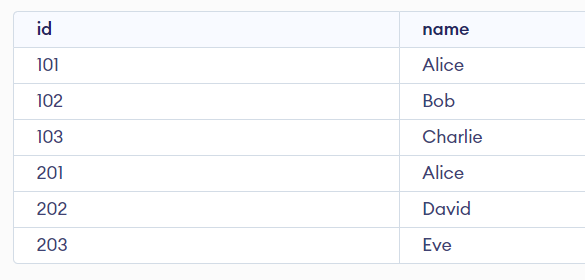In PL/SQL (Procedural Language/Structured Query Language), the UNION operator is one of the most commonly used set operators. It combines the result sets of two or more SELECT statements into a single result set while removing any duplicate rows.
In this article, We will learn about PL/SQL UNION Operator with the help of examples and so on.
PL/SQL UNION Operator
- The
UNION operator in PL/SQL, as well as in SQL is used to combine the results of two or more SELECT queries into a single result set.
- This operator is particularly useful for merging similar datasets from different tables or queries into one comprehensive dataset.
Syntax
The syntax of the UNION operator is straightforward. Here’s how you can use it:
SELECT column1, column2, ...
FROM table1
WHERE condition
UNION
SELECT column1, column2, ...
FROM table2
WHERE condition;
Explanation:
- SELECT column1, column2, ... FROM table1 WHERE condition: The first SELECT statement retrieves data from table1 based on a specified condition.
- UNION: The UNION operator combines the result of the first query with the second.
- SELECT column1, column2, ... FROM table2 WHERE condition: The second SELECT statement retrieves data from table2.
Example of PL/SQL UNION Operator
Step 1: Create Two Tables: employees and contractors
-- Create the employees table
CREATE TABLE employees (
employee_id NUMBER(5),
name VARCHAR2(50)
);
-- Create the contractors table
CREATE TABLE contractors (
contractor_id NUMBER(5),
name VARCHAR2(50)
);
Step 2. Insert Sample Data into the Tables
-- Insert data into the employees table
INSERT INTO employees (employee_id, name) VALUES (101, 'Alice');
INSERT INTO employees (employee_id, name) VALUES (102, 'Bob');
INSERT INTO employees (employee_id, name) VALUES (103, 'Charlie');
-- Insert data into the contractors table
INSERT INTO contractors (contractor_id, name) VALUES (201, 'Alice');
INSERT INTO contractors (contractor_id, name) VALUES (202, 'David');
INSERT INTO contractors (contractor_id, name) VALUES (203, 'Eve');
 Employees Table
Employees Table  Contractor Table
Contractor Table Example 1: Combining Results from Two Tables
Suppose we have two tables: employees and contractors. Both have columns for employee IDs and names. We want to get a list of all people working in our organization.
SELECT employee_id, name FROM employees
UNION
SELECT contractor_id, name FROM contractors;
Output:
 Combining Results from Two Tables
Combining Results from Two TablesExplanation: This query selects the employee_id and name from both tables and combines them. The UNION operator ensures that duplicate names are removed, resulting in a unique list of all workers, whether they are full-time employees or contractors. The result will include:
- All unique names from both tables.
- The combined list sorted in ascending order by default.
Example 2: Using UNION with Different Conditions
Let’s extend our query by adding conditions. Assume we want to list only those employees and contractors whose names start with the letter "A".
SELECT employee_id, name FROM employees WHERE name LIKE 'A%'
UNION
SELECT contractor_id, name FROM contractors WHERE name LIKE 'A%';
Output
 Using UNION with Different Conditions
Using UNION with Different ConditionsExplanation: The query filters out names starting with "A" from both tables and merges the results. The UNION operator ensures that duplicates are removed while combining the results. The output will:
- Include only names that start with "A".
- Exclude any duplicates between the two tables.
- Present the final list sorted in ascending order.
Conclusion
The UNION operator is a powerful tool in PL/SQL that allows for the combination of multiple result sets while eliminating duplicates. It is especially useful when you want to merge data from different tables that share similar structures. Remember, the number and types of columns must match across the combined queries.
Similar Reads
SQL UNION Operator The SQL UNION operator is used to combine the result sets of two or more SELECT queries into a single result set. It is a powerful tool in SQL that helps aggregate data from multiple tables, especially when the tables have similar structures.In this guide, we'll explore the SQL UNION operator, how i
4 min read
PL/SQL UNION ALL Operator In PL/SQL, the UNION ALL operator is a powerful tool that allows us to combine the results of two or more SELECT queries into a single result set. Unlike the UNION operator, which eliminates duplicate rows, UNION ALL includes all rows, including duplicates. This makes it faster and more efficient wh
4 min read
SQLite Union Operator SQLite is a server-less database engine and it is written in c programming language. It is developed by D. Richard Hipp in the year 2000. The main moto for developing SQLite is to escape from using complex database engines like MYSQL etc. It has become one of the most popular database engines as we
5 min read
PL/SQL Operators The PL/SQL language offers various operators for data manipulation and logical processing. There are several types of these operators which include arithmetic operators, relational operators, comparison operators, and logical operators. In this guide, we will learn about the various PL/SQL operators
3 min read
SQLite Union All Operator SQLite is a server-less database engine written in C programming language. It is developed by D. Richard Hipp in the year 2000. The main moto for developing SQLite is escaping complex database engines like MYSQL etc. It has become one of the most popular database engines as we use it in Television,
6 min read
PL/SQL IN Operator The PL/SQL IN operator is a powerful tool used in SQL queries to check if a value matches any value in a list or a subquery result. It simplifies querying multiple values and can make your SQL code cleaner and more readable. The IN operator is typically used in the WHERE clause to filter results bas
6 min read